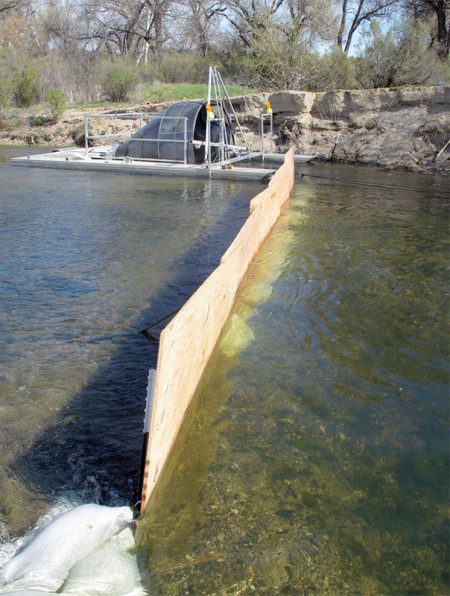Friday April 19, 2013
 When river flows are sluggish, creating a diversion can help give our rotary screw traps an extra push to keep fishing. These funnel-like traps monitor juvenile salmonids as they swim out to sea, and a screw-shaped structure inside the cone helps the trap turn freely under the force of flowing water, like a paddle wheel (see Some assembly required). The above trap should typically operate in 4 feet of water, but the depth of river in this photo is only about 2 feet. The shifting, sandy sediment of the riverbed partially filed the pool of this monitoring site over the winter, making it shallower. If you look closely at the photo, you can see the crossbar that spans the mouth of the cone is not resting across the floating pontoons, indicating the cone is not completely lowered.
When river flows are sluggish, creating a diversion can help give our rotary screw traps an extra push to keep fishing. These funnel-like traps monitor juvenile salmonids as they swim out to sea, and a screw-shaped structure inside the cone helps the trap turn freely under the force of flowing water, like a paddle wheel (see Some assembly required). The above trap should typically operate in 4 feet of water, but the depth of river in this photo is only about 2 feet. The shifting, sandy sediment of the riverbed partially filed the pool of this monitoring site over the winter, making it shallower. If you look closely at the photo, you can see the crossbar that spans the mouth of the cone is not resting across the floating pontoons, indicating the cone is not completely lowered.
Constructing a wall of diversion boards, weighted with sandbags, helps funnel more of the stream through the trap, increasing the force of water to turn the screw inside the cone. The spinning cone will eventually scour a deeper hole in the gravel for the trap to fish in. In addition to diverting water, the boards also create a roadblock that directs the flow of fish traffic. While we don’t catch enough fish on this river to conduct efficiency tests (see Efficiently incarcerating adolescent fish), anecdotal accounts and intuition suggest that these boards also increase the proportion of passing fish that the trap picks up.
